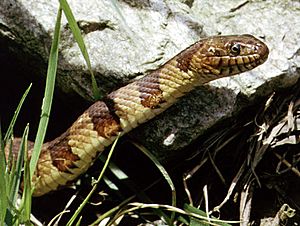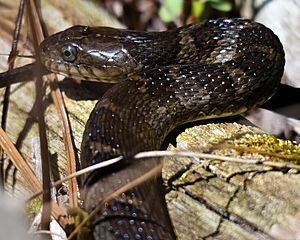Common watersnake facts for kids
Quick facts for kids Common watersnake |
|
|---|---|
 |
|
| Nerodia sipedon | |
| Conservation status | |
| Scientific classification | |
| Genus: |
Nerodia
|
| Species: |
sipedon
|
| Subspecies | |
|
Four, see text |
|
| Synonyms | |
|
|
The common watersnake (Nerodia sipedon) is a large snake found in North America. It is a very common type of snake and is not venomous, meaning it is harmless to humans. It belongs to a group of snakes called Colubridae.
Contents
- What Are Common Watersnakes Called?
- How to Identify a Common Watersnake
- Types of Common Watersnakes (Subspecies)
- Where Common Watersnakes Live
- Common Watersnake Behavior
- Reproduction and Life Cycle
- How Common Watersnakes Defend Themselves
- Common Watersnake Habitats
- Conservation Status
- Gallery
- See also
What Are Common Watersnakes Called?
The common watersnake has many different names. Some people call it the banded water snake or the northern water snake. Other names include black water snake, brown water snake, and eastern water snake. It is also known as the spotted water snake or water pilot.
How to Identify a Common Watersnake
Common watersnakes can grow quite long. They can reach up to 135 cm (4 ft 5 in) (about 4.4 feet) in total length. Female snakes are usually bigger than males. Females average 81.4 cm (2 ft 8 in) long, while males average 69.6 cm (2 ft 3+1⁄2 in).
These snakes can be brown, gray, reddish, or brownish-black. They have dark bands across their neck. They also have dark blotches on the rest of their body. As the snake gets older, its color gets darker. The patterns can become hard to see. Some old snakes might even look completely black.
The belly of the snake can also be different colors. It might be white, yellow, or gray. Often, it has reddish or black crescent shapes.
Common Watersnake vs. Venomous Snakes
The common watersnake is not venomous and is safe for humans. However, it looks a bit like some venomous snakes. People sometimes confuse it with the cottonmouth or copperhead. This confusion often leads to watersnakes being harmed.
You can tell the difference between them. The common watersnake has a longer, thinner body. Its head is flat and about the same width as its neck. It has round pupils in its eyes. It also does not have heat-sensing pits near its nostrils.
Venomous cottonmouths look different. They have a fatter body. Their head is shaped like a wedge. It is wider than their neck because of their venom glands. Cottonmouths have pupils that look like a cat's eye. They also have heat-sensing pits between their eyes and nostrils.
Types of Common Watersnakes (Subspecies)
There are four main types, or subspecies, of the common watersnake:
- N. s. insularum – This is the Lake Erie watersnake.
- N. s. pleuralis – This one is called the midland watersnake.
- N. s. sipedon – This is the northern watersnake.
- N. s. williamengelsi – This type is known as the Carolina watersnake.
Where Common Watersnakes Live
The common watersnake lives all over eastern and central North America. You can find them from southern Ontario and Quebec in Canada down to Texas and Florida in the United States.
These snakes have also been found in California since 1992. They are not native there. They are considered invasive species. This means they might compete with local snakes like the giant garter snake.
Common Watersnake Behavior
Common watersnakes are active both during the day and at night. You will often see them resting in the sun. They like to bask on rocks, tree stumps, or bushes.
During the day, they hunt near the water's edge. They look for small fish, frogs, worms, and crayfish. They also eat salamanders, small birds, and even tiny mammals. At night, they focus on small fish resting in shallow water. They use their sense of smell and sight to find food.
The Lake Erie watersnake is a special type of common watersnake. It was once endangered. But now, it eats a lot of round goby, an invasive species of fish. This new food source has helped the Lake Erie watersnake population grow.
Common watersnakes are very common in most places they live. If they feel threatened, they quickly dive into the water. If they are caught or cornered, they will defend themselves. Larger snakes can give a painful bite.
Reproduction and Life Cycle
Common watersnakes mate from April to June. They are ovoviviparous. This means the mother snake carries her eggs inside her body. She gives birth to live baby snakes. They do not lay eggs in a nest like some other snakes.
Baby watersnakes are born between August and October. Each baby is about 19–23 cm (7+1⁄2–9 in) (7.5 to 9 inches) long. A mother snake can have up to 30 babies at once. However, the average is about eight babies. The mother snakes do not take care of their young after they are born.
How Common Watersnakes Defend Themselves
Many animals hunt common watersnakes. These predators include birds, raccoons, opossums, and foxes. Snapping turtles and other snakes also hunt them.
When a common watersnake feels threatened, it defends itself strongly. If an animal or person picks it up, it will bite many times. It will also release a smelly liquid called musk. Its saliva has a mild substance that can make a bite bleed a little more. But this is not dangerous for humans.
Common Watersnake Habitats
Common watersnakes love to live near water. You can find them near lakes, ponds, marshes, rivers, and canals. They often hide among sticks and plant stems. Places like muskrat houses and beaver lodges are good spots to find them.
Conservation Status
The Lake Erie watersnake is a special subspecies. It lives mostly on the western islands of Lake Erie. These islands are near Ohio and Ontario. This snake was once on the list of threatened animals. This was because humans were harming them. Also, their homes were being lost or damaged.
In 1999, there were only about 1,500 adult snakes left. But on August 16, 2011, the U.S. Fish and Wildlife Service removed it from the endangered list. This was a big success story!
One reason for their recovery was a new food source. An invasive species called the Eurasian round goby fish entered Lake Erie. This fish became a main part of the watersnake's diet. By 2009, the snake population grew to almost 12,000 snakes. This was much more than the goal needed for recovery. The Lake Erie watersnake is one of the few species to be removed from the list because its population recovered.
Gallery
-
Preparing to molt, Prince Edward County, Ontario
-
Hunting on a beach near Georgian Bay, Ontario
-
Northern watersnake swimming in pond Hayesville, North Carolina
-
Basking in the sun along French Creek, Pennsylvania
-
N. s. insularum on Kelleys Island
See also
 In Spanish: Serpiente de Agua del Norte para niños
In Spanish: Serpiente de Agua del Norte para niños










